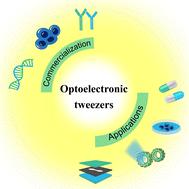当前位置:
X-MOL 学术
›
Chem. Soc. Rev.
›
论文详情
Our official English website, www.x-mol.net, welcomes your feedback! (Note: you will need to create a separate account there.)
Optoelectronic tweezers: a versatile toolbox for nano-/micro-manipulation
Chemical Society Reviews ( IF 46.2 ) Pub Date : 2022-10-26 , DOI: 10.1039/d2cs00359g Shuailong Zhang 1, 2, 3 , Bingrui Xu 1, 2 , Mohamed Elsayed 4, 5 , Fan Nan 6 , Wenfeng Liang 7 , Justin K Valley 8 , Lianqing Liu 9, 10 , Qiang Huang 1, 2, 3 , Ming C Wu 11 , Aaron R Wheeler 4, 5, 12
Chemical Society Reviews ( IF 46.2 ) Pub Date : 2022-10-26 , DOI: 10.1039/d2cs00359g Shuailong Zhang 1, 2, 3 , Bingrui Xu 1, 2 , Mohamed Elsayed 4, 5 , Fan Nan 6 , Wenfeng Liang 7 , Justin K Valley 8 , Lianqing Liu 9, 10 , Qiang Huang 1, 2, 3 , Ming C Wu 11 , Aaron R Wheeler 4, 5, 12
Affiliation

|
The rapid development of micromanipulation technologies has opened exciting new opportunities for the actuation, selection and assembly of a variety of non-biological and biological nano/micro-objects for applications ranging from microfabrication, cell analysis, tissue engineering, biochemical sensing, to nano/micro-machines. To date, a variety of precise, flexible and high-throughput manipulation techniques have been developed based on different physical fields. Among them, optoelectronic tweezers (OET) is a state-of-art technique that combines light stimuli with electric field together by leveraging the photoconductive effect of semiconductor materials. Herein, the behavior of micro-objects can be directly controlled by inducing the change of electric fields on demand in an optical manner. Relying on this light-induced electrokinetic effect, OET offers tremendous advantages in micromanipulation such as programmability, flexibility, versatility, high-throughput and ease of integration with other characterization systems, thus showing impressive performance compared to those of many other manipulation techniques. A lot of research on OET have been reported in recent years and the technology has developed rapidly in various fields of science and engineering. This work provides a comprehensive review of the OET technology, including its working mechanisms, experimental setups, applications in non-biological and biological scenarios, technology commercialization and future perspectives.
中文翻译:

光电镊子:用于纳米/微操作的多功能工具箱
显微操作技术的快速发展为驱动、选择和组装各种非生物和生物纳米/微型物体开辟了令人兴奋的新机会,其应用范围从微细加工、细胞分析、组织工程、生化传感到纳米/微型机器。迄今为止,已经针对不同的物理领域开发了多种精确、灵活和高通量的操作技术。其中,光电镊子(OET)是一种利用半导体材料的光电导效应将光刺激与电场结合在一起的最先进技术。在此,可以通过以光学方式按需感应电场的变化来直接控制微型物体的行为。依靠这种光诱导的电动效应,OET 在显微操作方面具有巨大优势,例如可编程性、灵活性、多功能性、高通量和易于与其他表征系统集成,因此与许多其他操作技术相比表现出令人印象深刻的性能。近年来关于OET的研究报道较多,该技术在科学和工程的各个领域发展迅速。这项工作全面回顾了 OET 技术,包括其工作机制、实验装置、在非生物和生物场景中的应用、技术商业化和未来前景。因此,与许多其他操作技术相比,表现出令人印象深刻的性能。近年来关于OET的研究报道较多,该技术在科学和工程的各个领域发展迅速。这项工作全面回顾了 OET 技术,包括其工作机制、实验装置、在非生物和生物场景中的应用、技术商业化和未来前景。因此,与许多其他操作技术相比,表现出令人印象深刻的性能。近年来关于OET的研究报道较多,该技术在科学和工程的各个领域发展迅速。这项工作全面回顾了 OET 技术,包括其工作机制、实验装置、在非生物和生物场景中的应用、技术商业化和未来前景。
更新日期:2022-10-26
中文翻译:

光电镊子:用于纳米/微操作的多功能工具箱
显微操作技术的快速发展为驱动、选择和组装各种非生物和生物纳米/微型物体开辟了令人兴奋的新机会,其应用范围从微细加工、细胞分析、组织工程、生化传感到纳米/微型机器。迄今为止,已经针对不同的物理领域开发了多种精确、灵活和高通量的操作技术。其中,光电镊子(OET)是一种利用半导体材料的光电导效应将光刺激与电场结合在一起的最先进技术。在此,可以通过以光学方式按需感应电场的变化来直接控制微型物体的行为。依靠这种光诱导的电动效应,OET 在显微操作方面具有巨大优势,例如可编程性、灵活性、多功能性、高通量和易于与其他表征系统集成,因此与许多其他操作技术相比表现出令人印象深刻的性能。近年来关于OET的研究报道较多,该技术在科学和工程的各个领域发展迅速。这项工作全面回顾了 OET 技术,包括其工作机制、实验装置、在非生物和生物场景中的应用、技术商业化和未来前景。因此,与许多其他操作技术相比,表现出令人印象深刻的性能。近年来关于OET的研究报道较多,该技术在科学和工程的各个领域发展迅速。这项工作全面回顾了 OET 技术,包括其工作机制、实验装置、在非生物和生物场景中的应用、技术商业化和未来前景。因此,与许多其他操作技术相比,表现出令人印象深刻的性能。近年来关于OET的研究报道较多,该技术在科学和工程的各个领域发展迅速。这项工作全面回顾了 OET 技术,包括其工作机制、实验装置、在非生物和生物场景中的应用、技术商业化和未来前景。



























 京公网安备 11010802027423号
京公网安备 11010802027423号